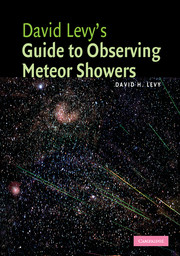Book contents
- Frontmatter
- Contents
- Preface
- 1 July 4, 1956
- 2 What is a meteor?
- 3 Some historical notes
- 4 Small rocks and dust in space
- 5 Observing meteors
- 6 Recording meteors
- 7 A New Year gift: the Quadrantids
- 8 The Lyrids – an April shower
- 9 The Eta Aquarids
- 10 The Omicron Draconids, continued
- 11 The Delta Aquarids
- 12 Tears of St. Lawrence: Perseid trails and trials
- 13 The August Pavonids
- 14 The Orionids
- 15 The Taurids
- 16 The Leonids
- 17 The Geminids
- 18 The Ursids
- 19 A catalog of meteor showers throughout the year
- Appendix
- Index
13 - The August Pavonids
Published online by Cambridge University Press: 06 July 2010
- Frontmatter
- Contents
- Preface
- 1 July 4, 1956
- 2 What is a meteor?
- 3 Some historical notes
- 4 Small rocks and dust in space
- 5 Observing meteors
- 6 Recording meteors
- 7 A New Year gift: the Quadrantids
- 8 The Lyrids – an April shower
- 9 The Eta Aquarids
- 10 The Omicron Draconids, continued
- 11 The Delta Aquarids
- 12 Tears of St. Lawrence: Perseid trails and trials
- 13 The August Pavonids
- 14 The Orionids
- 15 The Taurids
- 16 The Leonids
- 17 The Geminids
- 18 The Ursids
- 19 A catalog of meteor showers throughout the year
- Appendix
- Index
Summary
With this, the night darkened and lights and more
lights began to flit about the wood, much as the
gaseous exhalations of the earth flit about the sky and
look to us like shooting stars.
The Omicron Draconds and the August Pavonids are definitely not major events. In this book, however, they are awarded separate chapters because they both have personal stories that illustrate different aspects of the adventure of meteor observing.
The August Pavonids quest began surreptitiously on the morning of June 10, 1991. Waiting for the sky to clear, and with dawn approaching, I opened the sliding roof on my observatory. As the southeastern sky began to clear slightly, I began looking for comets in the constellation of Aries. After about a minute I spotted a bright hazy spot that I quickly identified as Messier 74. This distant galaxy is one of the faintest of the Charles Messier catalog objects that he came upon, also while comet hunting, two hundred years earlier. I greeted this old friend ever so briefly, and since the night was ending I moved on. After another minute, I saw another fuzzy spot, a bit brighter than M74. Could I have stumbled on Messier 74 a second time? No: besides being brighter, its field of surrounding stars was clearly different. More important, where the galaxy M74 had moderately sharp edges, this object showed the gradual fading at the edge which is more typical of the gas and dust in a comet.
- Type
- Chapter
- Information
- David Levy's Guide to Observing Meteor Showers , pp. 77 - 80Publisher: Cambridge University PressPrint publication year: 2007



